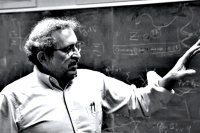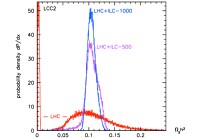Director's Corner
8 November 2007
 Barry Barish |
Cosmic Dark Matter and the ILC
A couple of weeks ago, Michael Peskin (SLAC) opened the ALCPG07 meeting at Fermilab with a visionary talk titled, “The Physics Landscape: Now and Tomorrow.” I sat in the audience and wondered what he would do with such a sweeping subject in only 30 minutes. Then Michael flashed his next slide. He revealed the intriguing subtitle, “How will we see the world of physics two years after the first data from the LHC?” This single question zeroed in on precisely what we must consider and anticipate as we develop a design and plans for proposing a linear collider to complement CERN's Large Hadron Collider. Michael continued, not as a prophet but more like a scientist, by describing the likely early science from the LHC and the opportunities it will present for the ILC.
Michael began his talk by briefly arguing why there must be new physics at the LHC, focusing on electroweak symmetry breaking. In his words, “the only good idea is to build a theory that has a weak coupled Higgs field and that requires breaking the symmetry.” I won't try to explain this particular theory here, but rather just emphasise that in such a scenario there will not be just one new particle, but a spectrum. This is one of the reasons why we expect to find so much rich new physics at the LHC. Following this line of thought one step further, we anticipate that in the longer term the combination of discoveries from the LHC and precision measurements at the ILC will enable us to determine the spins, couplings and other quantum numbers for the new particles that will be found.
It is more than an intriguing side bar to mention that predictions for physics beyond the Standard Model of particle physics may also explain one of the most important problems in astrophysics -- the nature of the dark matter of the cosmos. About 20 percent of the universe is thought to be made out of non-luminous or "dark matter." Observations strongly favor that dark matter consists of something other than ordinary (baryonic) matter. One of the leading explanations is that it is made out of a new form of matter, called weakly interacting massive particles or WIMPs. These particles could in turn be the supersymmetric particles we seek at LHC. This possible connection hasn't been lost on Michael, and he recently wrote a paper specifically on this subject entitled “Dark Matter and Particle Physics.”
In his paper, Michael reviews what we may expect at the LHC, based on theoretical approaches like supersymmetry that solve well-known problems in the Standard Model of particle physics. He describes why supersymmetric particles could also represent the dark matter and analyses how it could be proven that they are indeed the explanation for the astrophysical observation. In fact, these observations illustrate exactly how the ILC can play such a crucial role because it will determine the detailed characteristics of such new particles through precision measurements. Michael even briefly addresses the next question: “How can we use this knowledge to image the dark matter structure of the universe?”
If supersymmetric particles are found and studied in colliders, it will not be easy to show that they account for the relic dark matter density in the cosmos. This will be the case because discovering supersymmetric particles will require combining LHC and ILC measurements of the masses and cross sections. Scientists will then have to determine the particles' couplings and mixing angles to predict the relic dark matter density. These results can then be compared with astrophysical measurements. Such a comparison will require the high precision that can be achieved at the ILC and the LHC measurement for squarks, gluinos and the heavy Higgs bosons. The figure shows how well this can be done for a chosen supersymmetric model studied by Peskin and collaborators.
The possible convergence of accelerator particle physics observations at the energy frontier and observations of WIMPs in upcoming non-accelerator projects would provide an elegant solution. It would also beautifully demonstrate the unity of physics.
-- Barry Barish
Further reading on predictions of dark matter density from ILC and LHC measurements can be found in E. Baltz, M. Battaglia, M. Peskin and T. Wizansky, Phys. Rev. D74, 103521 (2006).


